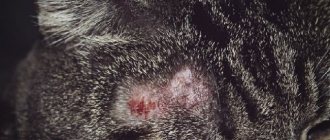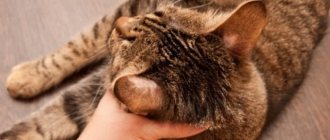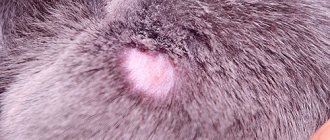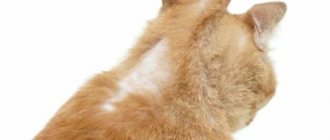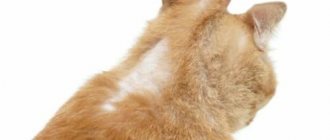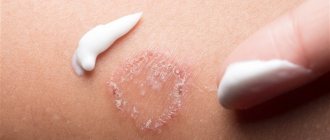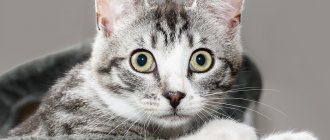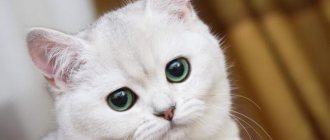How is feline ringworm treated in humans?
If, through carelessness or ignorance, one of the owners became infected with lichen from a cat, then you should not panic, but consult a doctor. In order not to infect others, you must follow all the recommendations received :
- treating affected areas of the skin with a solution of iodine;
- adhere to the prescribed diet;
- taking antifungal and antihistamine medications;
- need to refrain from taking a bath;
- Under no circumstances should you rub the skin with a washcloth;
- carrying out immunotherapy.
It is quite possible to cure feline lichen in humans. For this purpose, the following iodine-containing solutions are used, namely: iodopirone, iodoform, dermicide, antistrumin and others. Treatment of the disease also includes taking one of the antifungal agents: terbinafine, griseofulvin, inraconazole. Of course, the affected areas of hair or skin must be lubricated with ointment: exoderil, lamisil, clotrimazole or ketonazole.
At-risk groups
This skin pathology does not occur in all people; there are certain categories of the population that are at risk:
- Children - they often have ringworms in their hair and skin, which are transmitted to them from animals (cats, dogs).
- People with a hereditary predisposition - if one of the parents suffers from pityriasis or flat pathological process, then there is a high probability that their children will also suffer from it.
- Acquired or congenital immunodeficiency - insufficient functioning of the immune system increases the risk of getting shingles or lichen red.
- People with insufficient personal hygiene are a risk group for fungal infections of the body.
Ointments and shampoos for the treatment of lichen in cats
The most effective products produced in the form of ointments are:
- Clotrimazole - contains the active ingredient of the same name, which effectively helps eliminate ringworm in indoor and outdoor cats. The ointment must be applied to the area damaged by the fungus three times in 24 hours, and the course of treatment is about 30 days. Analogues of the drug - Mikosporin, Clotrisal. The ointment should not be used on pregnant or lactating animals. The drug can also be used in the form of tablets or spray.
- Sanoderm is an ointment containing betamethasone (anti-allergic, anti-inflammatory component), gentamicin sulfate (antibacterial component), nipagin (antiseptic), clotrimazole. The cream is distributed over the affected area twice a day, and after the animal’s condition improves - once a day. The course of treatment does not exceed 4 weeks. If re-treatment is necessary, you must wait 20 days.
- Miconazole is an antifungal agent with the active ingredient miconazole nitrate. To get rid of the fungus, it is enough to lubricate the lichen twice a day. The duration of treatment is from 1 to 2 months.
- YAM is a complex action ointment. The composition of the ointment provides effective control of parasites, while simultaneously providing an antiseptic effect on the infected area. Ringworm must be treated twice a day for 7 - 10 days. The animal's hair is not pre-cut. After completing the treatment course, new hair growth is observed at the site of the lesion. The drug is toxic, so it is not used to treat kittens.
- Griseofulvin is an effective antifungal agent that can be used to treat adult animals and kittens. The ointment is applied for 14 days, 2 times a day. To enhance the therapeutic effect, you can give Griseofulvin to cats in tablet form, adding them to food (0.25 tablets for adult cats and 0.12 tablets for kittens).
The range of effective antimycotics expands the anti-lichen shampoo for cats . The best known is Nizoral (the active ingredient is ketoconazole) and its cheaper analogue is Sebozol. The use of shampoos prevents the spread of lichen throughout the body and is suitable for the treatment and prevention of diseases.
Before treating ringworm in cats , you should consult with your veterinarian, as the instructions included with antifungal medications are often geared toward human awareness. Elimination of deprivation with the indicated doses of drugs can cause poisoning in pets.
Stages of development and characteristic symptoms of lichen
In the introductory part of our discussion, we presented two main variations of lichen in cats. The key differences between them are usually related to the length of the incubation period and the characteristics of symptomatic signs. To reveal more detailed information, we will try to study the intricacies of the development of these diseases one by one.
Trichophytosis in cats is recorded only in rare cases. The period of latent development of this disease, as a rule, does not exceed one month. External symptoms of lichen of this kind appear in the form of local inflammation of the skin areas located in relative proximity to the pet’s head and neck. However, occasionally there is an active spread of foci of infection in the area of the tail and hind legs. During the active phase of disease progression, the cat experiences noticeable weakness due to a sharp decrease in the level of immunity. In this regard, the affected animal quite often refuses to eat, which, of course, spontaneously leads to exhaustion of the body. In this case, the foci of infection are covered with characteristic scaly formations, which over time acquire a dark color tint. In this case, severe itching caused by skin lesions leads to pronounced redness of areas of the body. In some cases, inflammation of the hair follicles is also observed. Thus, at the site of the pathology, purulent pustules form over time, the rupture of which can ultimately lead to an even greater deterioration of the body’s condition.
Microsporia in cats by and large refers to a number of epidemiological diseases. Animals in this case become active carriers of fungal pathogens, provoking the onset of an epidemic in the human environment. The period of incubation progression in this case can reach 3 calendar months . That is why it is virtually impossible to detect the presence of this disease at its early stages. External signs begin to appear only in the later stages of development - local lesions appear on the body of the affected animal, covered with pityriasis-like crusts. The main affected areas include the head, neck, ears and torso. A characteristic symptom that allows one to distinguish microsporia from other types of skin diseases is increased hair fragility. So, in the affected areas you can observe some kind of imitation of short hair cutting. As a matter of fact, it is for this reason that this type of disease received its second name (ringworm).
Assessing the overall picture, we can identify the following symptoms of lichen:
- decreased immunity, drowsiness, fatigue;
- loss of appetite, weight loss;
- the appearance of bald areas in the head, neck and torso;
- the appearance of pityriasis crusts on the lesions;
- constant itching and redness of the skin.
Lichen itself can develop in domestic animals in three main forms , which can be described in the following way:
- superficial (fragility and hair loss, dryness and irritation of the skin, the formation of scaly plaque);
- deep (fusion of affected areas into single foci, redness and inflammation of the skin);
- atypical (local damage to small areas in the areas of the eyebrows, ears, nose, chin).
Finally, we will also talk about the diagnostic technique. The process of determining the type of lichen and its stage consists of two main stages:
- illumination of the affected areas with a Wood's lamp (local areas affected by the Microsporum fungus, under the influence of an ultraviolet source, acquire a pronounced emerald hue, while the lesions formed as a result of the activity of the Trichophyton fungus do not emit any characteristic glow);
- clinical study (analysis of samples taken by scraping allows you to obtain a more accurate result, eliminating variants of dermatitis, pyoderma, allergies, demodicosis and other pathologies associated with negative skin changes).
Ultimately, veterinary diagnostics will provide a finished result describing the type of lichen and the severity of the disease. Based on the data obtained during the study, the responsible doctor creates a health plan.
Treatment of deprivation
The treatment tactics for lichen are determined by the form and nature of the disease. In many cases, it is enough to put a protective collar on the cat against licking and promptly treat the affected areas of the skin with ointments; in severe cases, therapy should be comprehensive with the use of tablets, injections, and external agents.
It takes 2 weeks for skin wounds to heal, but complete recovery occurs in 4-6 weeks, provided that all the veterinarian’s recommendations are strictly followed.
Tablets, injections, and external remedies help to cope with ringworm. Before treating the sore spot, the hair around it is shaved off for better contact of the medicine with the skin. The list of drugs needed to treat ringworm:
- antifungal sprays (Dermazol, Nizoral);
- ointments (Yam, Lamisil, Miconazole);
- tablets (Terbinafine, Itraconazole, Griseofulvin).
Vaccines are used to treat and prevent disease in cats.
Trichophytosis in cats
Rarely found in cats. The incubation (latent) period lasts from 7 to 40 days. With trichophytosis, a cat usually has lesions on the scalp and neck, and sometimes lesions occur in the area of the tail and paws.
Clinical picture. A sick cat is depressed, often refuses food, and quickly loses weight. Upon examination, we note the formation of scales and crusts on the skin; the cat has severe itching. During a clinical examination, a veterinarian notes redness of the affected areas of the skin, areas of baldness are covered with a pityriasis-like coating. At the same time, we note the presence of small, sharply defined spots and tubercles, which, as the disease progresses, reach significant sizes. In some patients with cat trichophytosis, damage to the hair follicle may occur, where one or another pyogenic microflora enters. Subsequently, follicular pustules form at the site of the lesion, which burst after some time, leading to extensive purulent skin lesions.
Diagnostics
As with other diseases, only a veterinarian can make a diagnosis, confirm or refute your guesses.
The doctor will conduct a comprehensive examination:
- using a Wood's lamp, examine the affected area; the primary method will most likely indicate the presence of lichen - if the diagnosis is confirmed, the fur under the lamp will acquire a green tint;
- examination under a magnifying microscope makes it possible to examine skin scales in detail and see microsporia on the skin or hairs;
- analysis of the scraping for the presence of a nutrient medium - for analysis, a scraping is made from the affected area and sent to the laboratory to identify parasites and fungi.
The first two methods are carried out directly in the doctor’s office, take a few minutes, but do not give a 100% result. The culture is analyzed within 21 days, and its reliability is 100%.
Determination of ringworm with a Wood's lamp
Most types of lichen caused by fungus are determined using a Wood's lamp. The spores glow under the lamp with a bright green fluorescent color. The cat is brought into a dark room and ultraviolet light is directed at it.
Before the procedure, you should not treat the affected areas with ointments or powders, as this may complicate the diagnosis. The fact is that some medications also glow green when exposed to ultraviolet light.
You should also know that not all types of fungus can be determined using a Wood's lamp. For some species, you will have to take an analysis and do a culture. This method gives almost 100% results, but takes from several weeks to a month, since the spores grow for a very long time.
Local preparations
Typically, these drugs are applied to the affected areas of the animal. Since they are not safe for internal use, it is necessary to put a wide collar around the cat’s neck to prevent the pet from licking the medicinal product from the body.
Shampoos
Antifungal shampoos are used to treat lichen in cats. Their action alone will not relieve a meowing pet from the disease; it should only be used in a comprehensive manner. It is also not recommended to mix anti-lichen shampoos with regular shampoos.
Nizoral and Sebozol are considered good ones. They contain Ketoconazole, which is excellent against various fungi, infections and bacteria. It is necessary to wash your pet with shampoo 2 times a week for 1.5-2 months.
Ointments, sprays, creams
There are many liquid preparations that help fight lichen in cats, the treatment of which has long been neglected. Before using any ointments, sprays or creams, the animal's skin must first be prepared by cutting short the hair around the lichen spot.
To cure ringworm in a cat, it is recommended to use ointments that contain Clotrimazole. It perfectly helps get rid of fungi, although its use will last at least a month. More advanced products with his participation are Sanoderm and Fungin. Their action heals wounds, relieves inflammation and itching.
The drug Miconazole has a good bactericidal effect. By rubbing it into your pet's skin, it destroys lichen fungi. Yam BC ointment also helps eliminate various dermatological diseases, including ringworm.
But Imaverol can be used to treat lichen in pregnant cats and kittens.
A good option for getting rid of lichen would be sulfur and salicylic ointments.
The affected areas of the skin are lubricated generously with ointment twice a day. The advantage of these drugs is their low cost.
Features of therapy in children
Children are at risk of developing fungal infections of the body, as they can pet stray animals (cats, dogs), which are a source of infection. Treatment of lichen in children has its own characteristics:
- Preference is given to local forms of antifungal drugs (creams or ointments).
- Treatments for lichen must be as safe as possible for the child, since they are used for a long time.
- Therapy control should be based not only on the disappearance of symptoms, but also be laboratory confirmed.
It is very important not to self-medicate, as improper therapy will lead to the infection becoming resistant to drugs. In our clinic in Rostov-on-Don, a dermatologist prescribes therapy after establishing the etiological factor of the disease using a laboratory method.
Symptoms of the disease
Although each species is different, they have both common and individual signs of lichen in cats. General symptoms:
- hair loss in areas where the rash appears;
- inflammation, redness, dryness of the epidermis;
- constant severe itching.
Also, each species has separate, characteristic features.
Symptoms of ringworm
If your pet has contracted ringworm, there are several ways to identify it. Some parts of the fur will quickly fall out, but the rest of the coat will remain unharmed. Before this, the development of a small red rash on the body will begin. Because of them, the cat may itch for a long time. Often he finds no rest or suddenly wakes up from an attack of itching.
More developed lichen in cats can be determined by the following signs:
- the cat develops round spots covered with a crust of flaky skin;
- These areas are not covered with hair, and the hairs nearby thin out and become more brittle;
- if during the scratching process the cat scratches off part of the crust, a red smooth surface will be visible under it;
- over time, the spots increase in size and take on an oval or round shape;
- If the disease is not treated for a long time, hair will no longer grow at the sites of inflammation, as hard scabs will form.
The spots often cause discomfort and itch for animals. Depending on the pathogen, symptoms can affect the pet’s entire body or the head and neck separately. It also happens that some signs of lichen in cats are simply not expressed or are completely absent. This is called the apathetic form of the disease. In this case, only some hairs of the coat are susceptible to loss. Because of this, the disease becomes invisible to the naked eye, which means that the owner may not take any action to treat it for a long time.
Symptoms of pityriasis versicolor
Pityriasis versicolor in cats are pale, oval-shaped spots on the animal’s skin. They quickly spread throughout the body and after a few days occupy most of it. Then the spots begin to grow together, which can cause damage and deformation of the claws. In this case, the cat does not feel itching or any other severe discomfort. The spots may disappear if the surrounding temperature drops.
Symptoms of pityriasis rosea
Sometimes feline pityriasis rosea is confused with an allergy. The fact is that it appears as a small red rash on the skin. In some cases, the spots increase to 2 cm in diameter. A large accumulation of them is usually noticed on the pet’s stomach, in the groin and on the inside of the thigh. Itching is absent or almost not expressed.
The skin on which the spots appear becomes rough. If treatment has not begun for a long time, other microorganisms enter the lesions, which causes much more dangerous consequences, for example, sepsis. In some animals this is accompanied by fever, malaise, joint pain and swollen lymph nodes.
Signs of eczema
Weeping eczema is also characterized by red spots. But in this case, it hurts the pet when anything touches the lesions. The rash is small blisters with fluid inside. Sometimes they open, causing their contents to fall onto the surface of the skin. This is how infection and spread of the disease occurs. And although people should not be afraid of this disease, it sometimes causes febrile conditions in pets.
What is usually meant by the name “ringworm” is fungal diseases of the skin and scalp caused by special pathogens - the fungi Microsporum and Trichophyton. The difference between Microsporia and trichophytosis is that it is usually transmitted to humans from a sick animal, while trichophytosis is transmitted among people. These diseases are united by a clinical picture, which is represented by the appearance of flaky lesions with hair breaking off in the affected area. Specific complications include damage to internal organs when fungi penetrate the systemic bloodstream in weakened patients.
Trichophytosis is an anthroponotic (which means it affects people) fungal disease caused by the fungi Trichophyton violaceum and Trichophyton tonsurans. Infection usually occurs through direct contact with the affected areas of the skin of a sick person, or through the use of contaminated household items. Often the disease spreads when sanitary and hygienic rules are not observed in public places (schools, gardens, saunas, hairdressers).
Microsporia is a zooanthroponotic disease (affects both animals and humans) caused by the fungi Microsporum canis and audouinii. In this case, transmission of the disease occurs through contact with sick animals (fox, rabbit, cat, dog, rodents, sheep) or their fur. The peak incidence is observed in early summer and mid-autumn. Infection from person to person is extremely rare. The prevalence of the disease is higher among children and young women; older people get sick very rarely due to the presence of specific organic acids in the skin.
Predisposing factors for the development of ringworm are various chronic somatic diseases - glomerulonephritis, lupus erythematosus, immunodeficiency states, endocrine pathologies (especially diabetes mellitus, adrenal insufficiency), and many others. Immediate risk factors are work related to processing the wool of wild and domestic animals, contact with street animals, and living with a sick person.
Symptoms of the disease with trichophytosis depend on the form of the lesion. There are superficial and chronic forms of the lesion. With a superficial form of damage to the scalp or smooth skin, small or large lesions with irregular contours appear, covered with small scales (while the inflammatory phenomena are practically not expressed). A characteristic symptom is hair breaking off in the affected areas at a level of 1-2 mm above the skin. Externally broken hair looks like black dots deep in the skin, and the surrounding intact hair looks dull and pale.
The chronic form is characterized by the formation of atrophic areas and hair breakage. Individual pale atrophic lesions may be expressed with hair broken off at the skin level (“symptom of blackheads”), diffuse thinning of hair with unpronounced foci of atrophy may occur, as well as a predominance of thinned areas of skin throughout the head with single broken hair.
With microsporia, large foci of peeling 3-5 cm in size appear in the area of the back of the head or crown, as well as small daughter elements, as well as hair breaking off (unlike trichophytosis - 5 mm above the skin level).
A dermato-venereologist is involved in the diagnosis and treatment of fungal infections of the scalp.
Differential diagnosis is most often carried out with seborrhea, pityriasis rosea, and psoriasis.
For diagnosis, it is important to identify lesions and use techniques to identify the pathogen itself. To do this, a microscopic examination of the obtained material for fungi (scraping from the affected area) is used, which is then repeated several times during therapy. After this, the pathogen is cultivated on nutrient media in order to determine its species. Additionally, a general blood test and biochemical blood test are performed before and after therapy (antifungal drugs have severe toxicity).
For trichophytosis and microsporia, the following treatment regimens are used: Griseofulvin orally in 3 doses until a second negative microscopic examination is obtained. After this, every other day, and then once every 3 days until complete recovery. An alternative drug is Terbinafine or Itraconazole. Ointments with Ciclopirox, Ketoconazole or Bifonazole are used locally. Hair in the lesions is shaved every 5-7 days. Treatment takes an average of 1.5 months. The prognosis is favorable in most cases.
Symptoms
suspect lichen by how often the cat begins to itch, and the hair in the affected area loses its shine and begins to fall out. These signs accompany all forms of the pathological process, but based on individual symptoms, veterinarians and experienced cat owners can recognize exactly what form of the disease their pet has.
Shearer
The first sign of ringworm is restlessness and constant scratching by the cat in one area. If you part the fur and look closely, you will notice small flaky spots covered with crusts on the skin. The hair above them begins to fall out, and reddish skin is visible in the bald areas. Without treatment for ringworm in cats, the patches become covered with gray scabs and spread throughout the body.
Pityriasis
With pityriasis versicolor, only a small, pale, oval-shaped spot is noticeable on the affected area. After a few days, it increases in size, merges with neighboring ones, forming large lesions. If a cat's paw is infected with lichen, the infection can spread to the claw and cause its deformation. With pityriasis versicolor, the itching practically does not bother the cat; the spots can disappear on their own when the ambient temperature drops.
Pink
Pink ringworm of cats is accompanied by the appearance of pink round spots with a diameter of 1.5-2. Most often they affect the abdomen, groin area, and inner thighs. Itching is very mild or absent. The spots in the center are smooth, but flaky along the edges. Without treatment, they can become infected and lead to fever, joint pain, and inflammation of the lymph nodes.
Weeping
Red spots with small blisters that appear at the initial stage of lichen lichen are very painful when touched. The skin around the spots is hot. The bubbles are filled with liquid, which, when the reservoir ruptures, spills out and infects healthy tissue. A crust forms at the site of the burst bubble.
OOO "KTV-LUCH" - Official website
Ringworm: how to avoid getting infected?
Ringworm is a contagious disease. It is caused by a special microbe - a fungus that parasitizes the skin of humans and animals.
Fungi in humans affect the hair of the head, beard, skin of the face, hands, and torso. Children get ringworm more often than adults. People become infected with the fungus from each other. For example, through shared combs, hats, towels, pillows, washcloths, etc. Infection can also occur in a hairdressing salon if razors, clippers, scissors, and combs are not disinfected there.
Most often, children become infected when playing with stray cats and dogs. And also from calves, cows, horses, which can also suffer from ringworm. When infected with lichen, red spots appear on the patient's skin, often in the form of rings. They flake and sometimes itch. Round bald patches with broken, as if trimmed hair form on the head, which is where the name “ringworm” comes from.
With this disease, it is very important to start early treatment. In the first days, when there are only red spots on the skin, you can get rid of them easily. But when lesions appear on the head, treatment continues for 1.5-2 months. Children with ringworm are limited in their communication for the entire period of the illness.
Parents should know that ringworm is dangerous. Infection with it can occur when fragments of hair or scales from a patient get on the smooth skin or upper part of the head of a healthy person. Therefore, if suspicious spots appear, you should immediately consult a doctor. In addition, you need to remember a number of rules. Adults must know that the patient must always wear a cloth cap on his head in case of a disease of the scalp and a bandage in case of damage to the smooth skin. The underwear of such a person must be washed separately with mandatory boiling or at maximum temperature in a washing machine. At the end of treatment, final disinfection must be done. All members of the patient's family, including adults, should be examined by a doctor. A sick child has no right to attend school, kindergarten, or nursery. He must have a separate bed and personal items.
Ringworm, as already mentioned, can be contracted from sick people and animals. You cannot play with stray cats and dogs, much less put them on the bed. If the animal turns out to be sick, you need to take it to a veterinary clinic. After touching cats and dogs, as well as calves, cows and horses, be sure to wash your hands. You cannot use other people’s hats, combs, towels, or washcloths. And also notebooks, books, toys for children with ringworm. Don't sleep on someone else's bed or share a shared bed. Request that hairdressing salons disinfect their tools, and wash your hair with hot water and shampoo after a haircut.
At the first sign of ringworm, consult your doctor. Children, if they notice illness in their friends, immediately inform the teacher about it. It is necessary to strictly observe the cleanliness of the body, clothes and especially hands. Wash your face, hands and feet with soap daily. This is the key to fighting ringworm.
I. KABAKIN, chief physician of the Syzran Dermatovenerological Dispensary
"Volzhskie Vesti"
22:00, November 1, 2022, Friday / 10910 / SOCIETY Follow us on social networks
PARTNER NEWS
Ointment for ringworm in cats
To treat lichen in cats, complex therapy is used, which necessarily includes ointments. But all appointments must be coordinated with a veterinarian after tests and tests. Some components can only aggravate the situation, and the use of drugs before diagnosis can blur the picture.
Before treatment, the affected areas are washed with a cotton swab or disk soaked in warm water or chlorhexidine. Remove scabs and crusts, and also clean adjacent fur. In some cases, the hair around the spot is cut off. The affected area is dried and only then the ointment is applied, covering healthy areas by 1–2 cm.
Clotrimazole has anti-inflammatory and antifungal effects and is used to treat affected areas of the skin with weeping and ringworm. The ointment is applied in a thin layer to the skin two or three times a day. The course of treatment is at least a week; if necessary, the drug is used for 2–3 weeks. Repeated treatments are recommended after three weeks.
Sulfur ointment is used in the treatment of various forms of lichen. A small amount of ointment is applied to the affected skin, covering 1–2 cm of healthy skin. The course of treatment is from 10 to 20 days.
YAM BK ointment has a pronounced antifungal and antiseptic effect. The drug is applied to the skin in a thin layer (it is not necessary to remove crusts and scabs) 1-2 times a day for a week. In case of relapses, the course of treatment is repeated.
Terbinafine is used to treat fungal skin diseases caused by dermatophytes and lichen versicolor. The ointment is applied to the affected areas 2-3 times a day for 10-14 days. If necessary, the course is repeated after 14 days.
When using any ointments, it is necessary to protect the animal. Cats often lick medications, so you need to use a special collar.
Microsporia in cats
Microsporia in cats is of great epidemiological importance, due to the fact that cats are a source of infection and the cause of epidemics among humans (human microsporia). With microsporia, lesions in the form of flaky or crusty surfaces are located on the head, near the ears, on the inner surface of the ears, torso, and at the base of the tail. It is characteristic that microsporia causes hair fragility at approximately the same level from the skin itself, throughout the affected area. Upon visual inspection of such a lesion, the cat owner gets the impression that the fur has been cut, which is why this type of lichen received the name ringworm. Such hair can be pulled out easily and painlessly. The base of the hair is covered with a small sheath of fungal spores.
The disease in cats occurs in superficial, deep and erased forms..
The superficial form, when fully clinically manifested in a cat, is accompanied by hair loss and peeling of the skin in barely noticeable or large areas of the body. On clinical examination, such skin is swollen, with a bluish tint. In some cats, the superficial form occurs with a clearly expressed inflammatory reaction and the formation of crusts.
The deep form of microscopy is rare in cats.
Erased form - most common in cats, lasts for months (7-9 months). With this form, only individual hairs are affected on the mustache, nose, ears, eyebrows of the head, neck, base of the tail and other places.
The diagnosis of ringworm is made based on the clinical picture of the disease and the results of laboratory testing of affected areas of skin that have not been treated. In a veterinary laboratory, pathological material is examined under a microscope and then inoculated onto special nutrient media. At the veterinary clinic, specialists carry out express diagnostics using a Wood's lamp (under microscopy, we register an emerald green glow, but with trichophytosis there is no glow).
Differential diagnosis. When carrying out differential diagnosis, it is necessary to exclude demodicosis, dermatitis, pyoderma, and allergies.
Treatment. Ringworm involves isolating a sick cat in a separate room, which must be periodically ventilated and periodically wet cleaned with disinfectants.
Treatment depends on the severity of the disease, the number of affected areas and the state of the body's immune system. At the onset of the disease, veterinary specialists receive good results from the use of therapeutic and preventive vaccines. In the case when a cat has damage to large areas of the skin, antifungal drugs are used (Griseofulvit, Dermicotsid - produced in the form of solutions in ampoules of 5 ml, administered in a dose of 1-2 ml into the thigh area 2-3 times with an interval of 3-3 5 days). In case of a generalized process, these drugs are used both externally and internally.
Are traditional methods of treatment allowed?
Considering that a fungal infection causes lichen in cats, treatment cannot be based solely on lotions, rubbing with herbal tinctures and other methods with questionable effectiveness. Folk remedies can be used as an additional measure to enhance the effect of medical therapy.
Your task is to adhere to the prescribed treatment regimen, especially since drugs for external and internal use are inexpensive.
How to treat?
Below are common treatments for ringworm.
Important: If you notice such symptoms, you should immediately contact a veterinary clinic; do not self-treat with folk remedies or other methods!
Vaccination
Vaccination is the best way to treat lichen; it is better to leave this matter to a professional. Only a veterinarian can definitively diagnose dermatophytosis by prescribing the correct drug with a course of treatment.
When vaccinated, the following drugs are used to treat ringworm and other fungal infections:
- Polivac
- Vakderm F
- Microderm
Treatment at home:
If, after diagnosing ringworm, you cannot take your pet to a veterinary clinic, proceed to treatment for ringworm at home. Owners of cats should know that their pet must be kept away from other animals and people in order to prevent possible infection. Treatment with folk remedies is much less effective than vaccination.
Antifungal ointments.
This type of treatment is prescribed to sick cats with a mild form. Suitable only for short-haired or shaved long-haired pets. Veterinarians often prescribe thiabendazole or miconazole. It is necessary to isolate the cat from contact with people and animals.
Good nutrition plays an important role in treating a cat. When shaving long hair, it is advisable not to touch the affected areas, try not to scratch the sore spots, as this can cause spores to spread throughout the body and become severe.
Items used when treating a patient must be sterilized for reuse. Do not forget that spores of harmful fungi that cause lichen in domestic cats live for up to 2 years on household items.
Baths with sulfurous lime.
An effective method. Suitable for all types of cats. The only negative is the unpleasant smell. After the procedure, the fur takes on a yellowish tint. It is better to combine baths with antifungal ointments. Thus, the effectiveness of treatment will approach 100% recovery of the pet.
Pills
Terbinafine, Itraconazole, Griseofulvin . There are similar medications, but they can cause complications during treatment. Suitable for the treatment of complex forms of ringworm in cats. This type of method is used only if ointment baths do not produce results.
The process of disinfection of the house where the sick animal lives is mandatory..
Bleach will ensure complete removal of harmful spores. Treat sleeping area, cups, toilet, brushes, toys, nail clippers with a 1:10 solution of bleach and water. Use a steamer on your home's carpets and furniture, and if possible, boil the linens of the bed on which the cat was lying. Knock out bedspreads and rugs.
When treating a pet, use disposable sterile gloves, wash your hands thoroughly when in contact with the animal or its household item until the lichen is completely cured.
Lichen barn cats
What is lichen?
Ringworm is a fungal disease. That's right, scientifically, it's called dermatophytosis. Affects the skin and its derivatives - hair, claws.
There are three species of dermatophyte fungi that cause skin diseases in pets: Microsporum canis, Microsporum gypseum and Trichophyton mentagrophytes.
Microsporum canis is the most common species in cats and dogs. In the environment, spores of this fungus can live up to 1.5-2 years! Some animals may carry the spores and not show any skin lesions.
Microsporum gypseum lives in soil; Trichophyton mentagrophytes is most often carried by rodents.
Prevention
Following these rules will help you avoid getting infected and will save your cat:
- Vaccination of an animal against lichen.
- Never pet other people's cats. Teach your children to do this. Stray street cats are especially dangerous.
- Wash your hands with soap: every time you pet your pet; when you come home from the street; after contact with cat accessories: tray, toys, bed.
- Keep your cat away from dirty outdoor shoes and clothing. Wash your shoes when you get home. Clean your hallway regularly.
- Walk your cat in areas where there are no other animals. Avoid contact with stray animals. It is best to keep your pet in an apartment.
- Isolate a cat infected with shingles from other pets and children for the entire course of treatment.
- At the first indirect signs: restlessness, frequent scratching, take the animal to the veterinarian to make or rule out a diagnosis of ringworm.
Important!
Remember that timely detection of pathology and proper treatment will definitely return your pet to health and will not harm the health of your family!
Vaccination against ringworm
Therapeutic and prophylactic vaccinations against lichen in cats are carried out as part of complex therapy for an animal or for healthy animals as a preventive measure. Vaccinations are given to healthy kittens at the age of 3 months.
Therapeutic vaccination is the most effective modern way to get rid of fungal infections of the skin and fur of cats. Injections are given 2-3 times with an interval of 10-14 days.
Vaccines used in veterinary medicine:
- Polivac TM is a highly effective vaccine based on 8 types of strains of weakened fungi (trichophytin, microsporum). The effect of the vaccine lasts 12-14 months. To develop lasting immunity, a second vaccination is carried out 14 days after the first. Vaccination of healthy cats does not cause complications. After a year, revaccination is carried out.
- Vakderm-F is a drug based on non-living spores of ringworm. The injection therapy product is used simultaneously with topical medications (ointments, sprays). To completely cure an animal, 2-3 injections are enough. For preventive purposes, it is used to vaccinate kittens from 2 months of age and healthy adult animals. The effect of the vaccination occurs after 25-30 days. Vaccination is carried out twice with an interval of 1014 days.
- Microderm is a therapeutic injection veterinary drug with high effectiveness against ringworm. To achieve the result, the medicine is administered to the cat twice with an interval of 10-15 days. The product is characterized by low toxicity. Suitable for preventive immunization.
Important!
Injections against lichen cannot be used in the treatment of pregnant and lactating cats, animals with hyperthermia.
Common shingles vaccines for cats
Currently, only domestically produced vaccines against ringworm are available to veterinary specialists. Most of them are used in agriculture - both for cows and sheep, and for fur-bearing animals. For cats the following apply:
Vaccerm Vaccine for cats
It is made from cells of fungal cultures that cause dermatophytoses, although there is a misconception that the vaccine supposedly contains inactivated spores. Spores are a fairly large biological object, which, if introduced into a muscle, will definitely lead to inflammation even if it is non-viable, since the body will perceive it as a foreign body.
To obtain the vaccine, fungi are inactivated with formaldehyde; this substance is used to sterilize medical and veterinary instruments, as well as to preserve tissue obtained during operations for histological examination. The vaccine contains formalin at a concentration of 0.3%.
The vaccine can be used from the age of 1 month. According to the instructions, it is administered twice with an interval of 10-14 days; 20-25 days pass until stable immunity occurs. Thus, the effect of vaccination can be expected 30-40 days after the first injection.
The vaccine is available in powder form. Before injection, it should be diluted with saline solution. The prepared solution is stored for no more than 30 minutes. After this time, the remaining vaccine is disposed of. But, for example, if you need to vaccinate two kittens under 3 months of age, 1 bottle will be enough for both.
Preparation, contraindications, side effects are standard.
Vakderm-F
The same applies to this vaccine as to the previous one. Additionally, it contains the immunomodulator ribotan. The vaccine itself is liquid and does not require dilution. It can be used within 30 minutes after opening the bottle, so the bottle should be opened right in front of you.
Polivak-TM
It has the same properties and features as Vakderm, but formalin is not listed in the composition. Available in liquid form in 1 ml ampoules (1 dose), in various cases (depending on the age of the animal and the purpose of vaccination, treatment or prevention) the volume of administration of the drug varies from 0.5 to 2 ml (doses). The timing of administration and formation of immunity is the same as for Vakderm.
If "Vakderm" has a wide range of applications, it is designed for several types of animals, then "Polivak" is produced separately for cats, separately for dogs.
Microderm
The main properties are the same as those of the two previous vaccines. Available in dry and liquid form.
Vermette
Has the same properties as those listed above. Antigens were obtained by freeze drying.
Diagnosis of the disease
Only a veterinarian who will examine the cat and prescribe the necessary treatment can recognize the disease. It is possible to determine ringworm in a cat using one of the methods for diagnosing the disease:
- Isolation of an infectious agent in an environment that promotes its development. This diagnostic method is considered the most accurate. However, the study can take a long time - from 1 to 3 weeks.
A scraping from the surface of the animal's skin is placed in a special composition, where favorable conditions are created for the propagation of the pathogen. First, they simply observe it, and then study the grown microflora under a microscope.
- Examination of hair or skin scrapings under a microscope. This method is not as accurate as the previous one. It is not always possible to see the causative agent of a disease under a microscope. It often happens that this type of test gives a negative result for infected cats.
- Study using a Voodoo fluorescent lamp. This method is considered the least effective, and its results do not guarantee 100% reliability. Areas affected by lichen are highlighted in green. True, some harmless microorganisms glow, but fungi do not always glow in ultraviolet light.
It is important! If lichen is suspected, blood is taken from animals for laboratory testing.
What to do if you suspect lichen in cats
The first thing to do if you suspect lichen in a domestic cat is to isolate the sick animal. There is no need to lock him in a cage or any other tight confined space. A separate room or loggia is suitable if it is warm.
Next, you need to urgently contact a veterinarian for an accurate diagnosis. Its goal is to obtain information about the cause and causative agent of lichen. Based on the research, the doctor will be able to choose the right therapy.
Important: it is strictly forbidden to bathe your pet if you notice signs of lichen. Together with the water, the lichen spores will spread to the entire body, thus increasing the affected area many times over.
During the entire period of diagnosis and treatment of lichen in cats, the following recommendations must be followed:
- use separate dishes for a sick pet;
- if there are other animals in the house, then they need to be isolated, or better yet, removed from the premises for a while to prevent an epidemic;
- Carry out disinfectant cleaning more often, paying special attention to those places where your cat most likes to be;
- wash all bedding and rugs in a disinfectant solution;
- Treat upholstered furniture with a solution of water and vinegar.
The following means are used for disinfection:
- quartz lamp - you need to turn it on in an infected room for 20-25 minutes;
- hot water with the addition of bleach or any other chlorine-containing bleach for washing linen and towels;
- hot steam for processing upholstered furniture;
- water with the addition of bleach, alcohol, iodine, vinegar, soap-soda mixture or 3-4% chlorhexidine for washing surfaces.
Remember that you need to wash not only the floor, but also, if possible, walls, doors, tables, baseboards, paying special attention to corners, crevices and other hard-to-reach places.
Where and how can you get ringworm?
Ringworm is a contagious skin disease that can be transmitted to humans. Infection occurs in the following ways:
- Through direct contact with an infected animal or asymptomatic carriers (mainly long-haired cats).
- Through contact with contaminated environments and care items (including combs, brushes, mats, transport baskets, etc.).
Note! Not every contact with an infected animal inevitably leads to the development of the disease. People with strong immunity have many specific and non-specific defense mechanisms of the body that prevent infection. Young children are most susceptible to the disease.
Among animals, there are also certain factors that contribute to the infection and development of fungal infections:
- Repeated contact with infected relatives. For example, if several animals live in the house.
- Age. Kittens under one year of age and cats over 10 years of age are less resistant to infection.
- Anything that weakens the immune system: other diseases, parasites, poor feeding, poor ventilation, little sun and fresh air, stress, etc.
Symptoms of lichen in cats
The disease ringworm got its name for a reason - animals lose certain areas of their coat, as if they had been cut.
At the initial stage, the pathology manifests itself as a rash on the infected area of the skin. However, under the fur, especially in long-haired breeds, the primary signs may not be noticed.
In this case, careful observation of your pet's behavior will come to the rescue - he may become more anxious. Frequent scratching of certain areas of the skin may indicate that the kitten is infected with lichen.
Video
As the disease progresses, the symptoms of the disease become more pronounced: the animal develops round spots of baldness, and in the central zone of these spots the skin becomes covered with scales and peels off.
Danger to humans
We found that ringworm from cats is freely transmitted to humans.
Children and the elderly are susceptible to fungal skin diseases. Treatment of a person is a long process. A mild form of dermatophytosis can develop into a chronic form and negatively affect the entire functional activity of the body.
Over time, the infection weakens the immune system and becomes a conduit for many other diseases. A person can become infected through contact with a cat, even during the incubation period. Spores found on hairs can enter the human body when touched. Therefore, it is necessary to treat in the early stages, as quickly as possible, in order to prevent the spread of fungi.
Disinfection and prevention
When your pet is completely cured of the skin disease, it is necessary to treat the apartment for cat lichen. Sometimes it is not possible to disinfect an apartment. In such situations, the owners do not know what to do with the cat during treatment.
One option is to place him in a specialized clinic. While your pet is away, you need to thoroughly clean the entire room and wash all surfaces with bleach.
To prevent lichen, you need to get vaccinated in a timely manner, comb your pet's fur more often, bathe it once a week with soap, and not allow it to come into contact with other cats. This way you can significantly reduce the risk of developing lichen.
Your cat's health can be preserved with timely diagnosis and proper treatment. Without proper treatment, skin infections will develop stronger and stronger, which will lead to a worsening of the animal’s general condition.
Tags
in cats and in cats and in infected cats and in cats and in cats generalized cats and in cats it is necessary to feed Feeding dogs Feeding cats Feeding rodents Feeding birds Feeding dogs Feeding cats Feeding rodents Feeding birds Feeding dogs Cats treat cats themselves. The type of disease is not dangerous for the disease.
dry stockspeoplecareconditionsproductsvitaminsskiveterinary fleasmore detailsmitebirdstoilet
